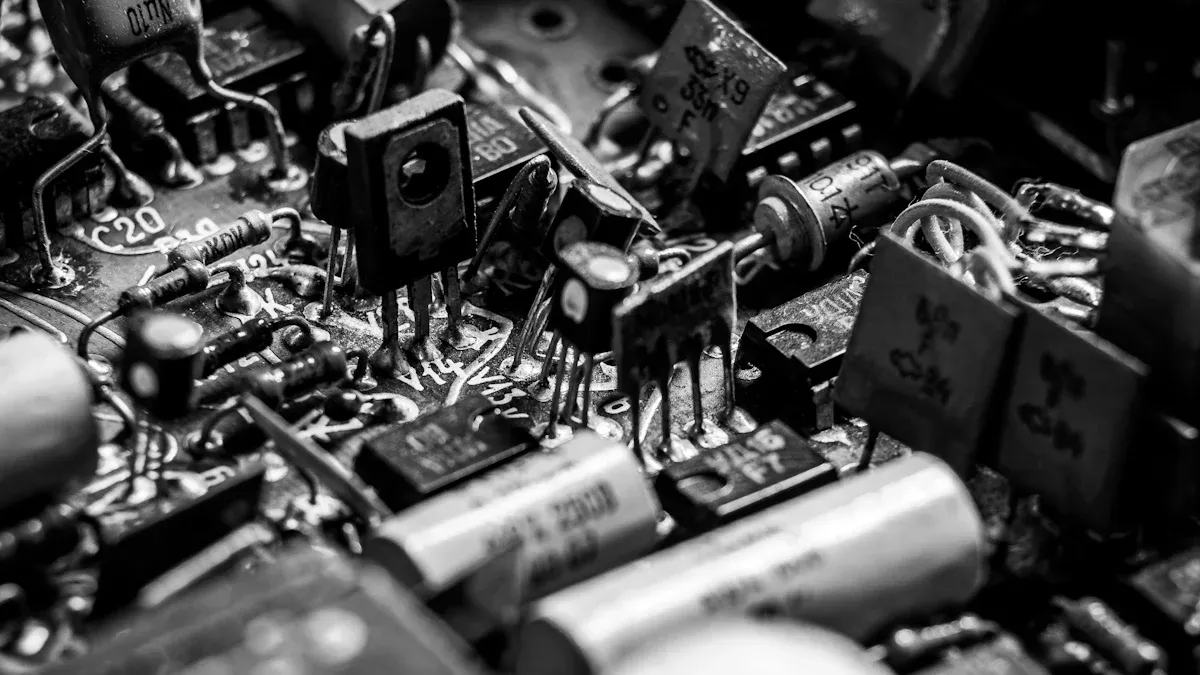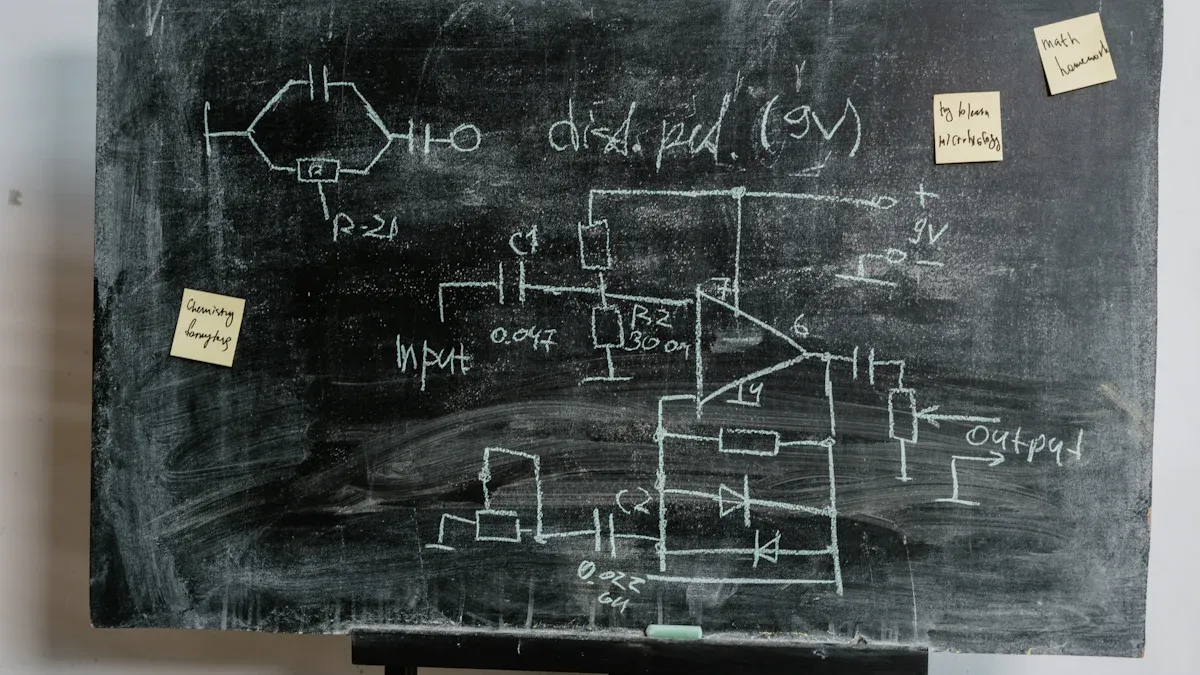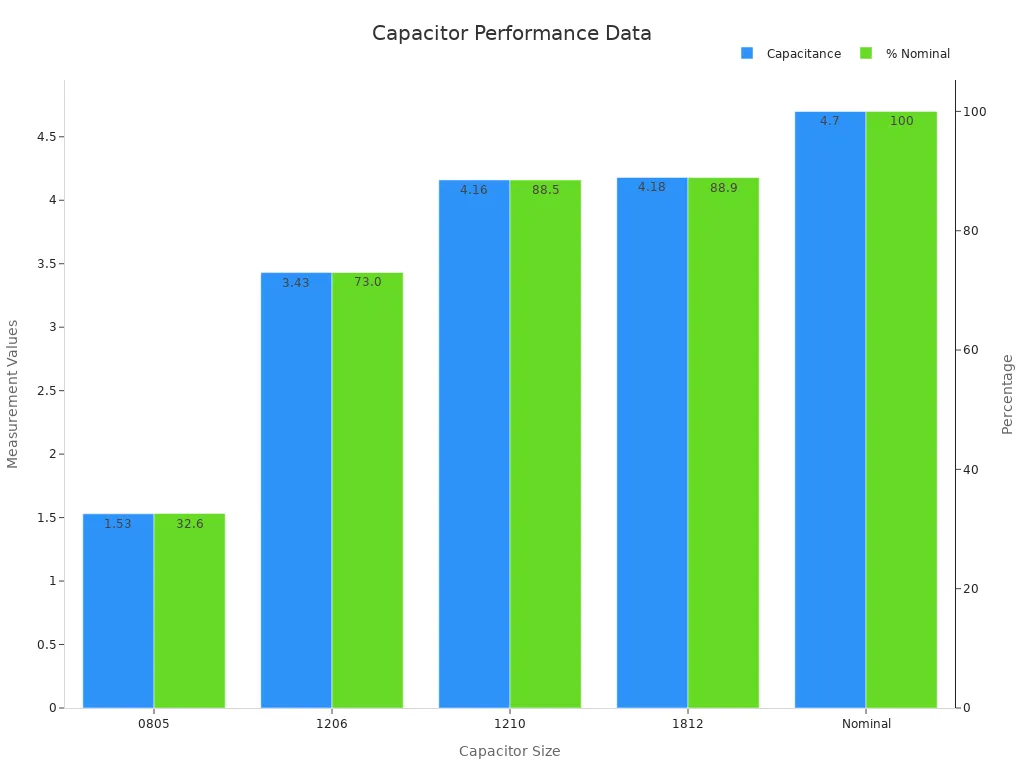Master Decoupled Capacitor Selection with These Proven Tips
Decoupled capacitors play a crucial role in electronic circuits. They help maintain steady voltage and reduce noise, ensuring that circuits operate effectively. Without decoupled capacitors, circuits may encounter issues such as noisy power or unstable signals. For instance:
Signal speed improves by 20% with effective decoupling.
Jitter decreases by 37.5%, resulting in clearer signals.
Power noise is reduced by 66.7%, enhancing circuit performance.
Careful selection and placement of decoupled capacitors are essential. This minimizes unwanted effects and stabilizes voltage. It allows capacitors to respond quickly to sudden changes in current, which keeps signals robust and minimizes interference.
Key Takeaways
Decoupled capacitors keep voltage steady and lower noise in circuits.
Picking the right size is key; too small causes problems, too big slows response.
Adding multiple capacitors together helps control noise at different frequencies.
Capacitors with low ESR work better, especially at high frequencies.
Place capacitors near power pins to reduce unwanted effects and boost reliability.
Check temperature and voltage limits to ensure they work in all conditions.
Mixing capacitor types, like ceramic and electrolytic, improves circuit performance.
Use online tools and datasheets to choose the best capacitors for your circuit.
Why Decoupled Capacitors Are Essential

The Role of Decoupled Capacitors
Keeping voltage steady in power supply lines.
Decoupled capacitors help keep voltage stable in circuits. When parts of a circuit need sudden bursts of power, the supply might not react fast enough. This can cause voltage to drop or change, which affects how the circuit works. Decoupled capacitors store energy and provide it when needed. For example, in fast digital circuits, they keep voltage steady even when processors switch quickly.
In real use, these capacitors are placed close to power pins of chips. This short distance helps prevent voltage problems. In smartphones, small ceramic capacitors (0.1 µF to 1 µF) are often used. They keep voltage stable and reduce noise from fast processor changes. This helps RF circuits and other sensitive parts work smoothly.
Cutting down high-frequency noise and interference.
High-frequency noise can harm circuits, especially with fast-switching parts. Decoupled capacitors block this noise by sending it to the ground. This stops the noise from spreading through power lines and affecting other parts.
Tests show how well decoupling reduces noise:
Measurement Type | Before Decoupling | After Decoupling | Reduction |
|---|---|---|---|
Radiated emissions at 1 GHz | -35 dBm | -55 dBm | 20 dB |
Conducted emissions at 150 kHz | -70 dBµV | -85 dBµV | 15 dB |
In smart home devices, these capacitors separate audio circuits from digital noise. This makes sound clearer and improves voice recognition. Using both large and small capacitors together helps block noise across different frequencies.
Problems Caused by Wrong Capacitor Choices
Unstable voltage and circuit problems.
Picking the wrong capacitor can make voltage unstable and cause problems. If the capacitor is too small, it won’t give enough energy during sudden power needs. If it’s too big, it reacts too slowly for fast changes.
An example from car manufacturing shows this issue. A car company had noise from high-power inverters that disrupted systems. They fixed it by using both large film capacitors and small ceramic ones. This reduced noise by 15 dB and met car standards.
More electromagnetic interference (EMI).
Wrong capacitors can also increase EMI, which harms nearby circuits. For example, capacitors with high resistance may not block high-frequency noise well. This can cause emissions that affect other devices.
To fix EMI, match the capacitor to your circuit’s needs. Use low-resistance capacitors and place them correctly on the board. Some PCB designs include built-in capacitance to lower EMI and improve reliability.
Tip: Always choose capacitors that fit your circuit. This avoids problems like unstable voltage or EMI.
Key Factors in Selecting Decoupled Capacitor Values
Understanding Capacitance
How capacitance affects energy storage and filtering.
Capacitance shows how much energy a capacitor can hold. It releases energy when needed to keep voltage steady. This helps stop sudden voltage changes in circuits. Higher capacitance stores more energy, which is good for circuits with big power changes. But too much capacitance can slow the capacitor's reaction time. This makes it less useful for fast-changing signals.
Capacitors also block unwanted noise by sending high-frequency signals to the ground. This keeps only the needed signals in the circuit. For example, in audio systems, capacitors remove high-frequency noise. This makes the sound clearer.
Typical capacitance ranges for decoupling applications.
Decoupling capacitors usually range from 0.01 µF to 100 µF. Small ceramic capacitors (0.01 µF to 0.1 µF) are great for blocking high-frequency noise. Larger electrolytic capacitors (10 µF to 100 µF) handle low-frequency noise and keep voltage steady. Picking the right size ensures your circuit works well at different frequencies.
Key Factors to Consider:
Dielectric permittivity affects how much energy capacitors can store.
Temperature limits stop capacitors from leaking or breaking down.
Tolerance shows the acceptable range of capacitor values for your circuit.
Frequency Response and Impedance
The relationship between frequency, impedance, and capacitor performance.
As frequency goes up, a capacitor's impedance goes down. This makes it better at blocking high-frequency noise. But at very high frequencies, parasitic inductance can raise impedance again. This lowers performance. So, choose capacitors with low impedance for your circuit's frequency range.
Characteristic | Importance in High-Frequency Circuits |
|---|---|
Saves energy and keeps the system efficient. | |
Well-Defined Frequency Response | Helps in filters and oscillators needing stable frequencies. |
Low Equivalent Series Resistance (ESR) | Reduces power loss and improves thermal stability for better performance. |
Low Phase Noise | Keeps signals clear and reduces noise in sensitive circuits. |
Why low ESR (Equivalent Series Resistance) is critical for high-frequency circuits.
Low ESR means less energy loss and better heat control. This is important for circuits that change current quickly. Capacitors with low ESR stay cool and last longer. They work well in power supplies and RF circuits, improving reliability and performance.
Matching Capacitor Values to Circuit Requirements
Identifying the power supply voltage and current needs.
To pick the right capacitor, know your circuit's power needs. Check the voltage and current your components use. For example, a microcontroller with 3.3V power might need both small and large capacitors. This keeps voltage steady and blocks noise.
Considering the operating frequency of your circuit.
The frequency of your circuit decides the capacitor size you need. High-frequency circuits need small capacitors with low ESR. Low-frequency circuits need larger capacitors to block noise. For example, in audio devices, capacitors remove noise and improve sound by focusing on certain frequencies.
Case Studies:
Power supplies use 104 capacitors to smooth voltage and boost efficiency.
Audio devices use 104 capacitors to block noise and improve sound quality.
Microcontrollers use 104 capacitors for accurate timing and smooth operations.
By knowing these factors, you can choose the right capacitor size. This ensures your circuit works well and stays reliable.
Practical Tips for Choosing Decoupled Capacitor Values

Using Multiple Capacitors in Parallel
Combining capacitors to handle different frequency ranges.
Using several capacitors together improves noise control. Each capacitor size works best for a specific frequency. Small capacitors, like 0.01 µF, block high-frequency noise. Larger ones, such as 10 µF, keep voltage steady during low-frequency changes. Together, they make circuits more stable and reduce noise.
This method also lowers electromagnetic interference (EMI). It keeps impedance low across many frequencies. This prevents resonance and ensures circuits work smoothly.
Examples of common capacitor pairs (e.g., 0.1 µF and 10 µF).
A popular pair is a 0.1 µF ceramic capacitor with a 10 µF electrolytic one. The ceramic capacitor blocks high-frequency noise. The electrolytic one stabilizes voltage at lower frequencies. Another example is using 0.01 µF and 1 µF capacitors for high-frequency circuits. These pairs improve decoupling in many devices.
Selecting the Right Capacitor Type
Pros and cons of ceramic, electrolytic, and tantalum capacitors.
The type of capacitor depends on your circuit's needs. Ceramic capacitors are great for high frequencies but have lower capacitance. Electrolytic capacitors handle higher capacitance but don’t work well at high frequencies. Tantalum capacitors are stable and have low ESR but cost more and are sensitive to voltage spikes.
Aspect | Ceramic Capacitors | Electrolytic Capacitors | Tantalum Capacitors |
|---|---|---|---|
Low to moderate | Moderate to high | Moderate to high | |
Frequency Response | Great for high frequencies | Poor at high frequencies | Good for medium frequencies |
Cost | Cheap | Affordable | Expensive |
Applications | High-frequency circuits | Power filtering | Stable power needs |
Choosing surface-mount or through-hole capacitors.
Surface-mount capacitors are small and good for high-frequency circuits. They reduce unwanted inductance and fit tight spaces. Through-hole capacitors are easier to handle and better for high-power uses. Use surface-mount for compact designs and through-hole for strong, high-current circuits.
Tools and Resources for Picking Capacitor Values
Using online tools and simulation software.
Online tools make capacitor calculations easy. They give quick results based on your circuit’s details. Software like LTspice and KiCad lets you test how capacitors perform. These tools help you pick the right values for your circuit.
Checking datasheets and application notes.
Datasheets show important details like ESR and voltage limits. Application notes give tips on choosing and placing capacitors. For example, graphs in datasheets show how impedance changes with frequency. This helps you pick the best capacitor for your needs.
Tip: Always compare datasheet details with your circuit’s needs for the best results.
Common Mistakes to Avoid in Decoupled Capacitor Selection
Overlooking Parasitic Inductance
How parasitic inductance impacts high-frequency circuits.
Parasitic inductance can weaken decoupling capacitors in fast circuits. Higher inductance raises impedance, making noise filtering harder. This can cause unstable signals and more electromagnetic interference (EMI). High-speed processors are especially affected by these problems.
Ways to reduce parasitic inductance in PCB design.
You can lower parasitic inductance by improving your PCB layout. Here are some simple tips:
Place capacitors very close to the power pins of chips. This reduces the loop area and lowers inductance.
Use multiple vias to connect capacitors to ground and power planes. This creates a better path for high-frequency currents.
Avoid placing capacitors far from chips. Older methods allowed this, but it increases inductance and lowers performance.
By following these steps, you can make your circuit more stable and reliable.
Using One Capacitor for All Noise Filtering
Why one capacitor cannot handle all frequencies.
One capacitor cannot block noise at all frequencies. Small capacitors stop high-frequency noise but miss low-frequency changes. Large capacitors handle low-frequency noise but react too slowly for high frequencies. Relying on just one type leaves your circuit open to noise problems.
Why combining capacitors works better.
Using different capacitors together covers more frequencies. For example, a 0.1 µF ceramic capacitor blocks high-frequency noise. A 10 µF electrolytic capacitor handles low-frequency noise. Together, they lower impedance and improve stability. This method makes circuits work better and last longer.
Ignoring Temperature and Voltage Ratings
How temperature changes affect capacitors.
Temperature changes can lower a capacitor’s performance. Higher temperatures can reduce capacitance, making filtering less effective. This can make circuits less stable. For example, small capacitors like the 0805 type can lose up to 32.6% of their capacitance in certain conditions.
Size | Capacitance (C) | % of Nominal |
|---|---|---|
0805 | 1.53 | 32.6 |
1206 | 3.43 | 73.0 |
1210 | 4.16 | 88.5 |
1812 | 4.18 | 88.9 |
Nominal | 4.7 | 100 |

Why voltage ratings must be higher than circuit voltage.
Choose capacitors with voltage ratings above your circuit’s voltage. Low-rated capacitors can fail early and harm your circuit. For example, in a 5V circuit, use a capacitor rated at 6.3V or higher. This prevents damage and ensures long-term reliability.
By checking temperature and voltage ratings, you can pick capacitors that work well in all conditions.
Choosing the right decoupled capacitors keeps circuits stable and working well. Correct capacitance and frequency response lower noise and improve power flow. Placing capacitors close to components reduces unwanted inductance and boosts reliability.
Benefits of Choosing the Right Capacitors | How It Helps Your Circuit |
|---|---|
Better stability and performance | Keeps voltage steady and ensures smooth operation. |
Quick energy supply and fast reaction | Protects signals and lowers electromagnetic interference (EMI). |
Shorter current paths and shared capacitance | Improves power flow and reduces inductance in the circuit. |
Avoid errors like using only one capacitor or skipping temperature checks. Picking carefully ensures your circuit runs efficiently and reliably.
FAQ
What does a decoupling capacitor do?
A decoupling capacitor keeps voltage steady and lowers noise. It gives quick energy when needed, helping parts work smoothly.
How do you pick the right capacitor for your circuit?
Think about your circuit's frequency, voltage, and current needs. Small capacitors block high-frequency noise, while big ones keep voltage stable.
Why use multiple capacitors together?
Different capacitors handle different frequencies. Using them together improves noise control and makes circuits more stable.
What is ESR, and why is it important?
ESR means how much a capacitor resists current flow. Low ESR reduces energy loss and heat, helping circuits work better.
Can one capacitor solve all noise problems?
No, one capacitor can't block all noise types. Using different sizes together filters noise across all frequencies.
How does temperature change affect capacitors?
Temperature changes can lower how well capacitors store energy. High heat can make them less effective, causing circuit problems.
What tools help choose capacitors?
Online tools, software like LTspice, and datasheets help pick the best capacitors for your circuit.
Why is capacitor placement on a PCB important?
Putting capacitors near power pins reduces unwanted effects. This improves performance and lowers interference.
See Also
Essential Steps You Shouldn't Ignore for Supercapacitor Testing
Exploring Various Capacitor Types and Their Unique Characteristics
A Look Back at Key Developments in Capacitor Technology
